
by Cora Buhlert
Through the Wall with a Bulldozer

Five years after the Berlin Wall was built, East Germans are still trying to overcome it and escape to the West, often with lethal consequences.
A particularly daring escape attempt happened last week in Staaken just outside Berlin. Four adults and a three-year-old child broke through the East German border fortifications – the so-called "death strip" – in a stolen bulldozer armoured with steel plates. The bulldozer flattened fences, concrete and barbed wire, until stopped by a tree.
Luckily for the five refugees, the tree was on the western side of the Wall, where the two families were rescued by western border guards.
Attack from Space
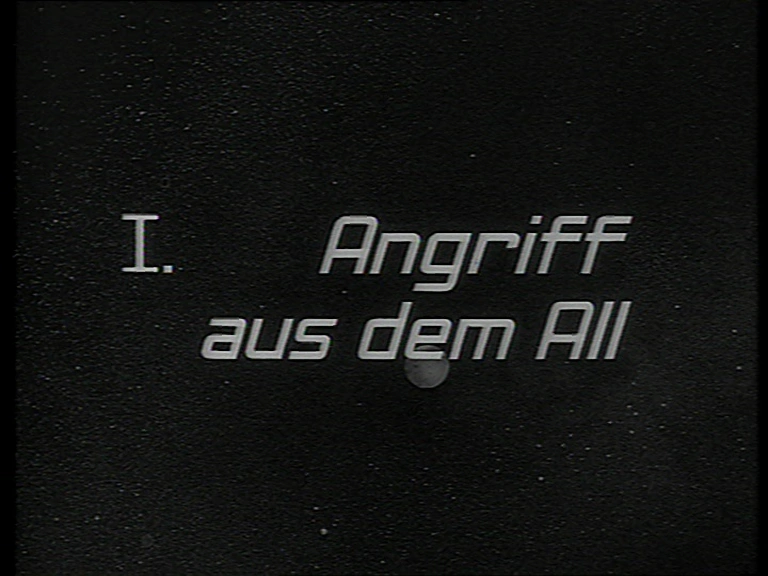
Meanwhile, on Saturday, September 17, West Germany's first science fiction TV series debuted on the broadcaster ARD.
The series has the unwieldy title Raumpatrouille – Die Phantastischen Abenteuer des Raumschiffs Orion (Space Patrol – The Fantastic Adventures of the Spaceship Orion), which viewers have already shortened to Raumpatrouille Orion or just plain Orion.
Like the new US series Star Trek, Space Patrol Orion starts with an opening narration, courtesy of veteran actor Claus Biederstaedt, which promises us a fairy tale from the future. In the year 3000 AD, nation states have been abolished. Humanity has settled the ocean floor and colonised far-flung worlds. Starships, including the titular Orion, hurtle through space at unimaginable speeds.
An impressive title sequence and a spacy and very groovy theme tune follow, courtesy of Peter Thomas, who also supplies the music for the Edgar Wallace and Jerry Cotton movies.
Then the show plunges us directly in medias res aboard the fast cruiser Orion 7 and introduces the five person crew: Commander Cliff Allister McLane (Austrian actor Dietmar Schönherr, who is the German dubbing voice of both James Dean and Sidney Poitier), chief engineer Hasso Sigbjörnson (Claus Holm), weapons officer Mario de Monti (Wolfgang Völz, who's best known for comic roles), astrogator (that's Orion speak for navigator) Atan Shubashi (F.G. Beckhaus) and space control officer Helga Legrelle (Ursula Lillig). As the names and the opening narration indicate, the series is set in a multicultural, postnational future, though so far, all characters are played by white actors.

When we first encounter the Orion crew, they are trying to land on the Saturn moon Rhea, while orders telling McLane to stop and return to base echo from the communication system. McLane, however, chooses to ignore those orders.
Most dialogue in the opening scene is gadget speak (and not even regular gadget speak, but a lot of Orion-specific terms), yet it tells us a lot about the characters. Right away we learn that McLane is a Maverick who views orders as strictly optional suggestions. We also learn that his crew trusts him and that they are very competent at what they do.
Where Clothes Irons Control Space Ships
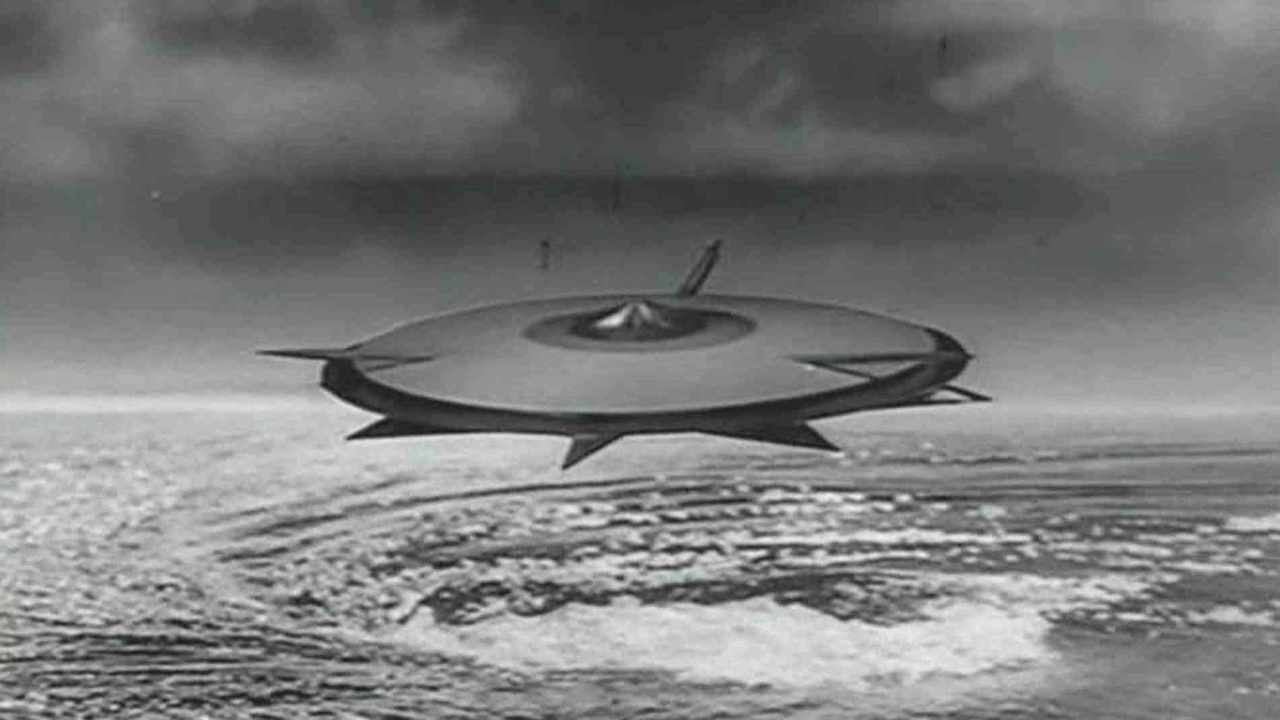
This is as good a time as any to talk about the Orion herself. Unlike the silver rocketships that still abound in visual science fiction, the Orion designers decided to go with a saucer shape, enhanced with fins and a transparent dome.
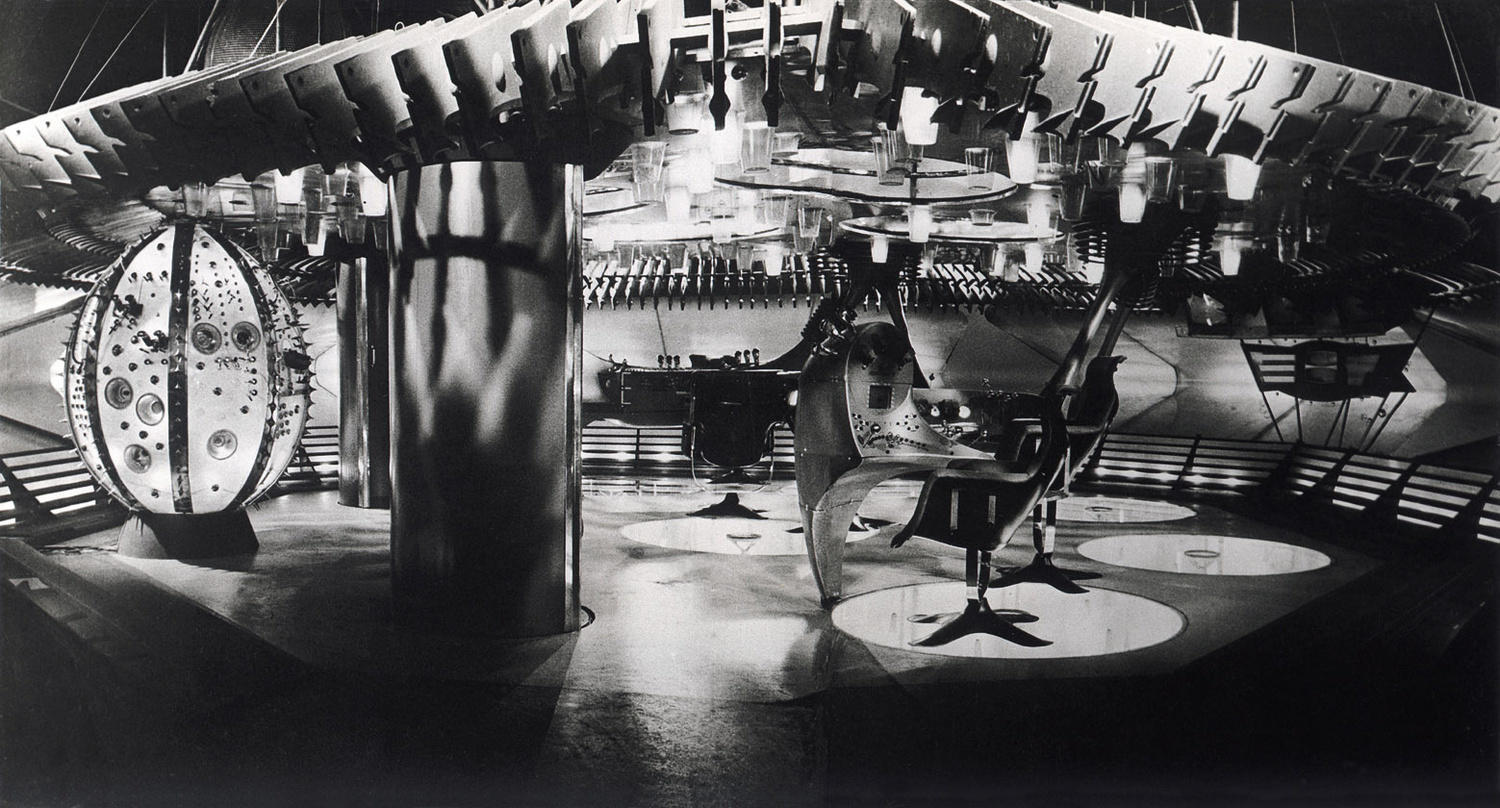
The Orion has an impressive command bridge – courtesy of set designer Rolf Zehetbauer – with boldly curved control stands, flashing lights, beeping oscilloscopes and a massive, egg-shaped computer. Every available surface is covered with futuristic looking bits and bobs. If you look closely, some of those bits and bobs seem oddly familiar, since they are repurposed household objects such as pencil sharpeners, bathroom tabs, plastic cups and in one memorable moment, a Rowenta clothes iron.

Zehetbauer also makes copious use of the kind of modern furniture I discussed in my article on interior design last year. In fact, you can spot several of the pieces featured in that article in the show.
Women in Command
The scene shifts to an anonymous office, where one General Wamsler (Benno Sterzenbach) is expecting a fellow general, General van Dyke of the Fast Space Fleet Command. I'm sure I'm not the only one who did a double-take when General van Dyke entered, because the General is a woman, portrayed by theatre actress Charlotte Kerr.
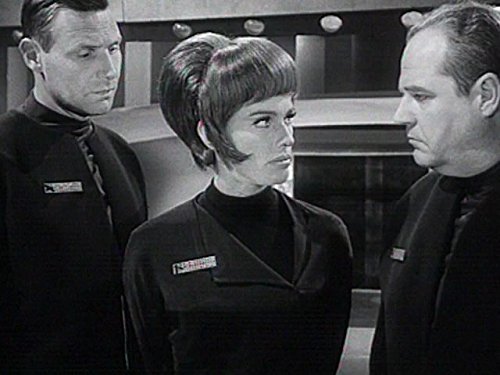
We still see way too many all-male spaceship crews and all-male future militaries, so the presence of a female general was a breath of fresh air. Nor is General van Dyke the only female character of note in this episode. Indeed, there are four named and one unnamed women with speaking parts in this episode alone. Alas, all the women in the future have the exact same beehive hairstyle, only in different colours.
We already met Lieutenant Helga Legrelle, the sole female member of the Orion crew, though so far the script doesn't give her much to do. In this scene, we meet another female character, Lieutenant Tamara Jagellovsk (Eva Plug) of the Galactic Security Service, who promises to play a prominent role in the series.

McLane's flagrant disregard for orders has caught up with him, so General Wamsler demotes him and the Orion to space patrol service – against the wishes of McLane's direct superior General van Dyke. There are hints that McLane and General van Dyke have history – on professional and private level.
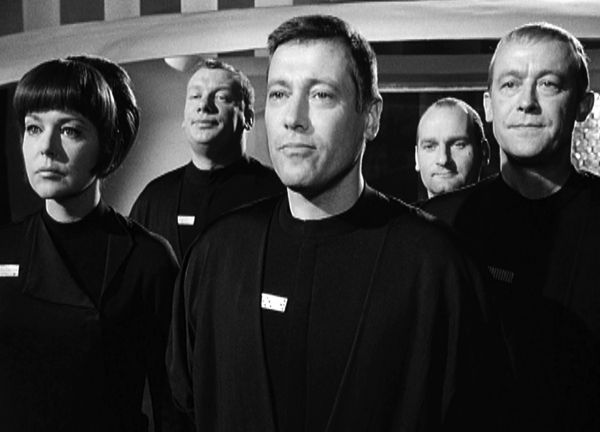
As if being demoted isn't humiliation enough, McLane is also assigned a watchdog, the above-mentioned Tamara Jagellovsk. Based on the first episode, the interaction between those two promises to be very interesting.
Dancing under the Sea
Before the Orion and her crew set off on space patrol duty, they relax in the grooviest nightspot in town, the Starlight Casino. The name is something of a misnomer, because the Starlight Casino is located on the ocean floor and instead of stars, oversized fish can be seen swimming beyond the transparent ceiling dome.

The Starlight Casino is a stunning set and I have no idea how Bavaria Atelier was able to build something like this on a West German TV budget. The set is not really underwater, but on a soundstage, while the fish are swimming in the aquarium of the Munich zoo and were copied into the scene via the magic of bluescreen technology.

The nightclub scene also adds some characterisation and worldbuilding. We learn that astrogator Atan Shubashi is worried about his dog 264, one of the last 376 poodles on Earth. We also learn that chief engineer Hasso Sigbjörnson has promised his wife Ingrid (Lieselotte Quillig) to retire, but wants to go on one last mission and ropes McLane into breaking the news to Ingrid.
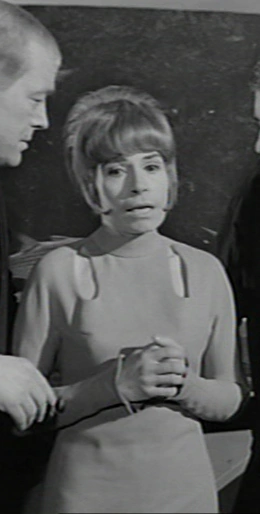
During all this, extras are performing a fascinating dance routine to electronic music in the background. Science fiction tends to assume that people in the future will dance the same way we do and probably to the same music, too, but Orion does not make this mistake. And so the background extras perform an oddly formal dance (created by choreographer William Millié), where couples dance back to back. I suspect this dance will be a big hit in dance classes throughout West Germany.
One thing that impressed me about Raumpatrouille Orion are the many little worldbuilding hints dropped into the story. Why exactly do people in the year 3000 AD dance like that? Why are poodles almost extinct? What was the Second Interstellar War and for that matter, what was the first? When did people of European origin start eating with chopsticks, as many of the characters do, when using chopsticks in present day West Germany will have people staring at you as if you were a unicorn?
A lot of science fiction worlds end at the bulkheads of a spaceship or the atmosphere of a planet, but in Orion, there clearly is a world and culture beyond the little slice that we see. I hope that future episodes will explore that.
Trouble in Space
Once the Orion takes off and emerges from the ocean in a stunning special effects sequence, trouble soon find McLane and his crew.
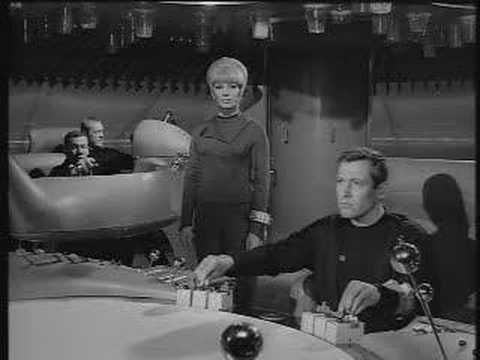
For starters, McLane and his watchdog Tamara Jagellovsk don't get along at all. McLane alternately ignores Tamara, sends her to her cabin like a naughty child and snipes at her. Tamara, however, is no pushover and gives as good as she gets, while Hasso and weapons officer Mario de Monti watch in amusement. Mario, who's something of a womanizer, clumsily attempts to flirt with Tamara – without success. Meanwhile, Hasso wonders whether Tamara is actually a robot. Considering that there are references to robots being more efficient than humans scattered throughout the episode, I wonder whether this isn't foreshadowing a later revelation.

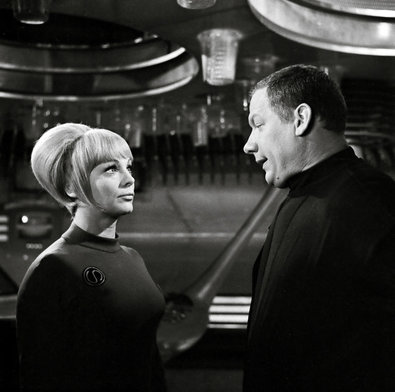
But whether she's human or a sophisticated android, I really like Tamara, especially when she dresses McLane down for his patronising behaviour such as calling her "My dear child".
The Orion runs into a solar storm (another impressive effect) and then into a dead satellite. McLane wants to blow up the satellite, because it's a hazard to space traffic. Tamara countermands him in what will become a pattern.
Atan Shubashi reports that he cannot raise the satellite relay station MZ-4 on the radio and only receives nonsense code. McLane wants to investigate, because the MZ-4 crew are friends. Tamara tries to override McLane again, but McLane points out that if they don't fix the transmitter problem, an automated space cruiser will crash into MZ-4. And no, they cannot contact the cruiser themselves, because the dead satellite that Tamara would not let McLane to blow up is disrupting communications in the region. "Shall I send them a postcard?" an impatient McLane snaps.
So Hasso and Atan get into a Lancet, a spherical shuttle that looks very much like a modern lamp, to investigate. McLane also orders Hasso and Atan to wear space suits, because when a transmitter fails, a life support system may fail as well.


If a character announces they will retire after "one last mission" like Hasso did, this is often a death sentence. And Atan is the only other crewmember who has someone waiting for him at home, so I became seriously worried about those two.
The Mystery of MZ-4
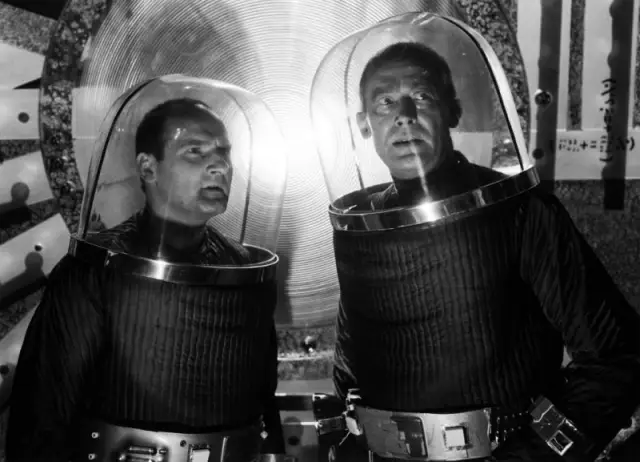
And not without reason, for once Atan and Hasso reach MZ-4, they find the station without power and oxygen. The crew is dead, frozen in mid movement, and the transmitter is set to a frequency not used by humans.
The scenes of Atan and Hasso exploring the darkened station, their heavy footsteps echoing on the metal floors, are genuinely spooky. Though the discovery of the dead crewmen is marred by the fact that one actor blinks at the crucial moment.

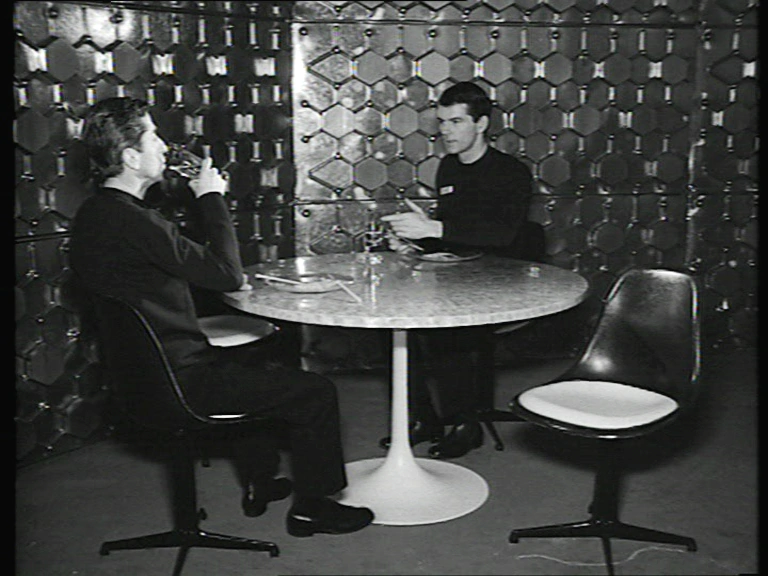
Atan and Hasso are still trying to figure out what the hell happened, when they spot a curiously glittering, elongated humanoid shadow. Aliens – or "exo-terrists" in Orion speak – have taken over MZ-4 and they turn out to be immune to rayguns.
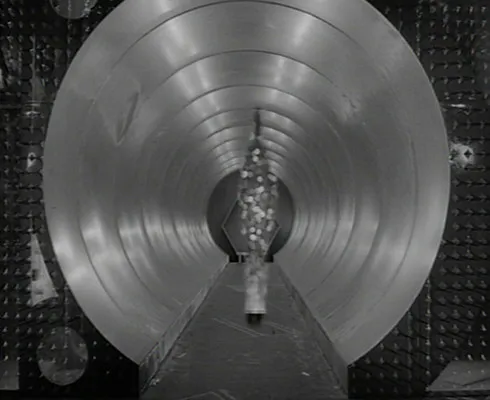

In filmic science fiction, aliens are all too often humans in rubber masks. However, Orion's exo-terrists – or Frogs, as Hasso and Atan nickname them – look truly alien. The glittering shadows were created via bluescreen technology.
Hasso and Atan call McLane who orders them to get the hell out of there. However, more trouble is coming, for Helga Legrelle detects seven unknown spaceships heading for the Orion. Worse, Hasso and Atan find that their Lancet has been sabotaged and cannot take off.
Space Battles and Moral Dilemmas
McLane promises to come back for them and goes off to fight the alien ships, only to find that the Orion's weapons are as ineffective as Hasso's raygun. The only course of action left is to return to Earth and warn everybody of the impending invasion.
However, Hasso and Atan are still stuck on MZ-4. McLane doesn't want to leave his friends behind. Tamara points out that Atan and Hasso are most likely already dead and the station is in the hands of the aliens. She orders McLane to destroy the station. McLane grudgingly agrees, but can't bring himself to press the button that will kill his friends. Not that it matters much, because the Orion has no firepower left after the encounter with the alien ships.
McLane may be a Maverick who ignores orders, but his first priority is to save lives. Therefore, I was disappointed that the convenient power failure took the decision whether to kill his friends and potentially save humanity out of his hands.
A Good Old Astounding Solution
But Atan and Hasso are still very much alive, though about to be overrun by aliens. They figure out that reason the aliens shut down the life support system is that oxygen is toxic to them. So Hasso uses the oxygen cartridge from his spacesuit to kill the aliens.
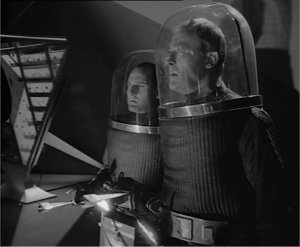
As solutions to cosmic mysteries go, this one was pretty clever. It feels like something that John W. Campbell might have published in Astounding twenty years ago. And indeed, the entire MZ-4 sequence with its try and fail cycles feels very Campbellian.
Hasso's cunning plan works. The aliens are overcome by oxygen and reduced to a pile of glitter on the floor. However, there's still the automated cruiser Challenger, which is headed straight for MZ-4 and will crash into the station, if not given a course correction. And Atan and Hasso can't hail the cruiser. What saves them in the end is ironically the aliens, who have placed a forceshield around MZ-4, blowing up the Challenger before she can hit the station.
A Meeting of Generals
The episode concludes at a conference table, where several military men – and this time around, they're all men; General van Dyke is presumably away on a mission – discuss what has just transpired.
General Wamsler, whom we already met, as well as the delightfully named Marshal Kublai Krim (Hans Cossy) and commander-in-chief Sir Arthur (Franz Schafheitlin) want to blow up MZ-4 in a pre-emptive strike against the aliens (at this point, they don't yet know that Hasso and Atan managed to take them out). The lone dissenting voice is Colonel Villa (Friedrich Joloff), head of the Galactic Security Service and Tamara's boss, who points out that maybe it would be better to find out what the aliens want first. Joloff is best known for playing villains, so it was nice to see him in a more nuanced role.

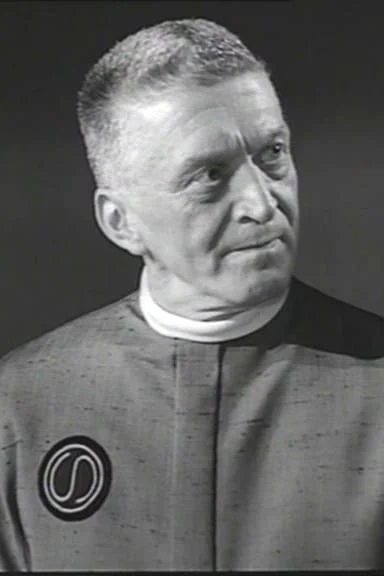
The "shoot first and ask questions later" policy very much matches postwar West Germany's view of unscrupulous generals who will do anything to eliminate a perceived threat, regardless of the loss of life.
The reunited Orion crew heads to the Starlight Casino to celebrate, including Tamara who has made peace of sorts with McLane and the rest of the crew. Tamara also reveals that she knows that McLane lied about the dead satellite disrupting communications and tells him never to lie to her again.
"This was just a nightmare, wasn't it?" Hasso, who's still shaken from his ordeal, asks Atan.
"Worse," Atan replies, "That was science fiction."
Science Fiction for Grown-ups
When my fellow Travellers here at the Journey raved about the new American show Star Trek, I was jealous, because Star Trek seems to be exactly what filmic science fiction so rarely offers, namely serious stories for adults that can compete with written science fiction. Little did I know that I would get my wish fulfilled only nine days later in the form of Space Patrol Orion.
Because Orion is exactly that: a serious science fiction story for adults and one that looks amazing, too. The beginning is a little slow and the MZ-4 plot is taken straight from a 1940s issue of Astounding. But comparing Raumpatrouille Orion to stuff like Familie Hesselbach (The Hesselbach Family), Stahlnetz (Steel Web) or Hafenpolizei (Harbour Police), which dominates the West German airwaves, is like comparing a Volkswagen to a Mercedes. Honestly, I had no idea that West Germany was even capable of producing something like Orion.
I hope that writers Rolf Honold and W.G. Larsen (a joint pseudonym used by Hans Gottschalk, Helmut Krapp, Oliver Storz, Theo Mezger and Michael Braun) will lay off the gadget speak, which is sure to scare away the mundanes, and focus more on the characters and their interactions. Because Orion has intriguing characters played by some of our best actors, so let's make use of them.
Episode 2 will air in two weeks and I for one can't wait.
Four and a half stars.

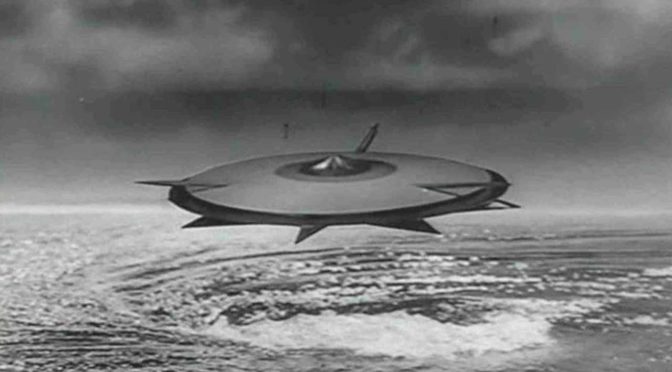

It really was astonishingly good. A little old-fashioned at times, as you note, but impressive.
You may be on to something with your theory that Tamara might be a robot. Her insistence on following orders to the letter would give a stereotypical Prussian officer pause. That dead satellite is clearly a hazard to navigation. American SF tends to model on the British Navy in the Age of Sail, when captains were out of touch for long periods of time and had to operate independently. Of course, McClane has command in his ear almost constantly, so his situation is a little different.
The weird thing about that iron is that the camera seemed to draw attention it. There were a couple of panning shots of the control room that really focused on it. Seems like an odd directorial choice.
I'm also looking forward to the next episode a lot.
Regarding English language science fiction being modelled on the age of sail, one thing I noticed is that the various high-ranking officials we see have army rather than navy ranks, i.e. they are generals, not admirals. Orion creator Rolf Honold comes from a stereotypical Prussian military family and is a WWII army veteran (mountain infantry), so maybe he just drew on the models he knew.
As for Tamara being a robot, one thing I noticed that that when the camera zooms in on the actors (which it does a lot), you them emoting and you also see beard stubble, pimples, etc… which makes them seem human. Tamara, however, barely twitches an eyebrow and her face seems oddly masklike, probably due to the heavy make-up.
I also wonder why the iron is placed so prominently. Especially since the other common household objects used like pencil sharpeners, clock pendulums, bathroom taps, plastic cups are not nearly as notable.
I was visiting some friends outside of Cologne when this came on and we were all thoroughly entertained. Even though I only have a rudimentary knowledge of German it was still pretty easy to follow.
I think what most impressed me is it really felt like a fully fleshed out future, not just the 60s in funny wigs as so often happens.
Well, I hope you enjoyed Cologne. If you didn't understand every word of the gadget speak, don't worry. Most of it is nonsense anyway. Though the dialogue is really good, when they're not gadget-speaking.
Well, the wigs of the women are probably the most 1960s thing about the series, unless women in the year 3000 will still near suffocate themselves with hairspray to achieve that beehive look.
And yes, the fleshed out future world is a nice departure from the cardboard worlds that most filmic and even a lot of written science fiction offers up.
I hope we see more of General van Dyke, she seems fun (in a stern sort of a way.) And I do hope Helga gets something more to do.
The set design is impressively busy… I'm not quite sure how well it stacks up against "Star Trek", though. The Orion's bridge is well-supplied with doo-dads and gizmos, but it lacks the overall coherence of the Enterprise bridge, with the core functions (command , helm and navigation) in the centre and the supplementary stuff (comms, science, auxiliary workstations) around the rim. On the other hand, though, "Star Trek" so far has no equivalent to the Starlight Casino. It's going to be interesting to see how "Raumpatrouille" gets around the problem of landing on planets, given that there's no equivalent of the Trek transporter – are they going to drop Lancets onto outside broadcast sites?
And one little detail of this well-realised future appeals to me strongly – I just love the GSD's worm logo!
I like General van Dyke a lot and hope to see more of her. And since Helga is part of the crew, we're sure to see more of her.
From the photos I've seen (Star Trek doesn't yet air in West Germany), Star Trek seems to go with bold colours a clear organisation for its bridge, whereas Orion goes for doodads and gizmos and a very textured look, probably because the show is shot in black and white.
Atan and Hasso used the Lancet, because MZ-4 is too small for the Orion to land, which is mentioned in the dialogue. And in the take-off sequence, we see that the Orion has a kind of retractable landing stalk, which should allow them to land on planets. And since there are six more episodes, I'm sure they'll land on a planet at least once.
And yes, the GSD worm logo looks great and nicely sets the GSD officers apart from the space fleet personal, as does the different colour and cut of their uniforms.
I did think it was a little weird that a West German show had the Political Officer as one of the heroes. Something I'd expect more from East German scientific fictions.
Speaking of European stuff, how are you enjoying Season 2 of "Thunderbirds?"
I think the GSD is more of an intelligence agency, but both Tamara and Colonel Villa are portrayed as positive characters, which surprised me particularly in the case of Villa.
Thunderbirds still has another week before the new series airs in the UK (at least in my region). But I enjoyed the first series. It is not at Doctor Who or Out of the Unknown level and often relies too heavily on dated cultural stereotypes but it is generally a fun show. I often think of it as A Fall of Moondust, the TV series.